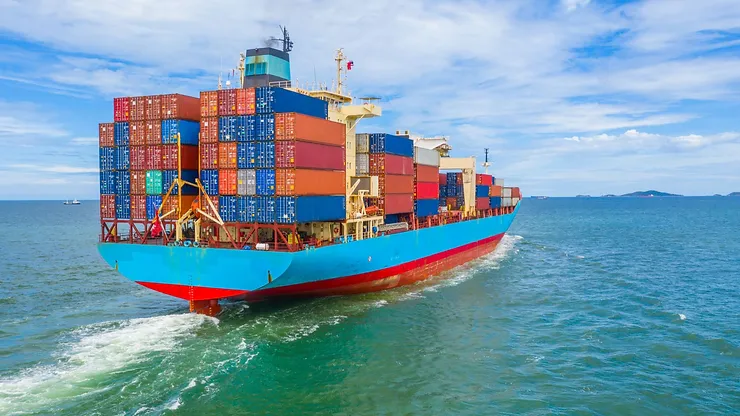- By TOP CHINA FREIGHT
- September 8, 2025
- Sea Freight, Shipping
Table of Contents
Businesses of all sizes rely on sea freight from China to South Africa to transport large shipments economically. Yet, many face challenges such as unexpected port delays, customs complexity, and fluctuating freight rates. This guide explores practical strategies to plan shipments efficiently, reduce costs, and ensure timely deliveries while navigating logistics challenges.

What factors influence sea freight costs to South Africa?
Costs fluctuate based on multiple variables:
1.Port fees
Vary depending on Durban, Cape Town, or Port Elizabeth.
2.Fuel surcharges:
Tied to global oil prices.
3.Container type
FCL (full container load) vs LCL (less-than-container load).
4.Seasonality
Peak seasons like Chinese New Year drive up rates.
5.Customs duties and VAT
Depend on product category and South African tariffs.
Understanding these factors allows importers to forecast budgets and select cost-effective options.
Which container options are available for sea freight?
Container choice affects both cost and efficiency.
Forwarders often suggest FCL for predictability, while LCL is useful for SMEs with smaller volumes.
How long does shipping from China to South Africa take?
Transit times vary by port, route, and service type.
| Port Pair | Sea Freight | Air Freight | Notes |
|---|---|---|---|
| Shanghai → Durban | 18–25 days | 3–5 days | Most common |
| Guangzhou → Cape Town | 22–32 days | 4–6 days | Suitable for bulk |
| Ningbo → Port Elizabeth | 20–30 days | 3–5 days | Alternative South African port |
Planning in advance ensures shipments arrive aligned with demand cycles.
How to streamline customs clearance for sea freight
Customs is often a bottleneck in South Africa. Forwarders simplify this with:
- Accurate documentation preparation.
- Coordination with licensed customs brokers.
- Pre-submission of commercial invoices and packing lists.
| Required Documents | Purpose |
|---|---|
| Bill of Lading | Proof of shipment ownership |
| Commercial Invoice | Declares cargo value |
| Packing List | Details package contents |
| Certificate of Origin | Confirms manufacturing country |
| Import Permit (if needed) | Required for restricted goods |
Proactive customs management reduces delays and penalties.
What strategies reduce sea freight costs?
Reduces per-unit cost for smaller imports
Shipping outside peak seasons avoids surcharges
Nearby ports may offer lower handling fees
Maximize container space to reduce wasted volume
Leverages professional negotiation for rates
Tips for Packaging and Loading Efficiency
Proper packaging maximizes container utilization and prevents damage. Businesses should consider palletizing goods, using shrink wrap, and minimizing empty space. Efficient loading reduces freight costs per CBM and ensures safer handling, which is especially important for fragile or high-value items.
Case Study: Cost savings through FCL shipping

A South African textile importer switched from LCL to FCL containers from Guangzhou. While the upfront container cost was higher, the per-CBM cost decreased by 30%. The forwarder also handled warehouse consolidation and customs, ensuring on-time delivery for seasonal demand. This case illustrates how strategic planning in sea freight improves both costs and reliability.
Should SMEs use sea freight or air freight?
Small and medium-sized enterprises benefit from LCL sea freight when volumes are modest. Although slower than air freight, LCL offers significant cost savings. Air freight is suitable only for urgent shipments or high-value goods where speed outweighs cost. Combining sea freight with forwarder services ensures SMEs can maintain cash flow while importing efficiently.
Pros and cons of sea freight from China to South Africa
| Factor | Sea Freight | Air Freight |
|---|---|---|
| Cost | Lowest per CBM | Highest per kg |
| Transit Time | 18–35 days | 3–7 days |
| Cargo Type | Bulk, heavy | Urgent, fragile |
| Reliability | Dependent on ports | Very reliable |
| Environmental | Lower emissions | High emissions |
Conclusion
Shipping via sea freight from China to South Africa remains the most economical solution for bulk or large-volume cargo. Planning container types, transit schedules, and customs documentation in advance ensures smooth deliveries. Working with a professional forwarder helps reduce costs, manage documentation, and improve supply chain efficiency. Proper strategy allows businesses to maintain reliability while minimizing shipping expenses.
Need a Shipping Quote?
If you want expert guidance and peace of mind, our team is ready to assist.
TJ China Freight offers tailored solutions to help businesses of all sizes ship more reliably from China.

FAQs
Q1:How can I track my sea freight shipment?
Most forwarders provide digital tracking, showing vessel location, ETA, and customs updates. Real-time monitoring ensures inventory planning.
Q2:Can small shipments use LCL?
Yes, LCL is ideal for small volumes. Forwarders consolidate cargo from multiple clients, reducing per-unit cost while ensuring proper handling.
Q3:Do I need cargo insurance?
Insurance is recommended to protect against damage, theft, or loss during sea transit. Many forwarders offer policies covering full shipment value.
Q4:How long does customs clearance take in South Africa?
Typically 1–5 days if documentation is complete. Forwarders coordinate with brokers to minimize delays and avoid penalties.
Q5:Are there seasonal fluctuations in shipping costs?
Yes, rates increase during peak periods like Chinese New Year or pre-Christmas. Booking early reduces exposure to surcharges.
